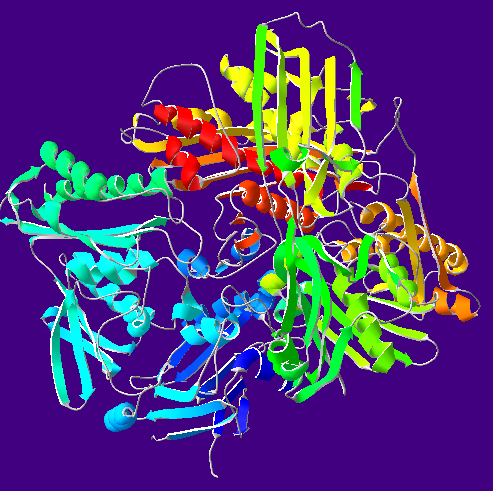Xanthine oxidase
Please Take Over This Page and Apply to be Editor-In-Chief for this topic: There can be one or more than one Editor-In-Chief. You may also apply to be an Associate Editor-In-Chief of one of the subtopics below. Please mail us [1] to indicate your interest in serving either as an Editor-In-Chief of the entire topic or as an Associate Editor-In-Chief for a subtopic. Please be sure to attach your CV and or biographical sketch.
Overview

The enzyme xanthine oxidase, or XO, (bovine milk enzyme is PDB: 1FIQ, EC 1.17.3.2) catalyzes the oxidation of hypoxanthine to xanthine and can further catalyze the oxidation of xanthine to uric acid
Reaction
- hypoxanthine + O2 + H2O ↔ xanthine + H2O2
- xanthine + O2 + H2O ↔ uric acid + H2O2
-
hypoxanthine (One oxygen)
-
xanthine (Two oxygens)
-
uric acid (Three oxygens. Diagram is rotated.)
Protein structure
The protein is large, having a molecular weight of 270,000, and has 2 flavin molecules (bound as FAD), 2 molybdenum atoms, and 8 iron atoms bound per enzymatic unit. The molybdenum atoms are contained as molybdopterin cofactors and are the active sites of the enzyme. The iron atoms are part of [2Fe-2S] ferredoxin iron-sulfur clusters and participate in electron transfer reactions.
Active site and mechanism of xanthine oxidase
The active site of XO is composed of a molybdopterin unit with the molybdenum atom also coordinated by terminal oxygen (oxo), sulfur atoms and a terminal hydroxide. In the reaction with xanthine to form uric acid, an oxygen atom is transferred from molybdenum to xanthine. The reformation of the active molybdenum center occurs by the addition of water. Like other known molybdenum-containing oxidoreductases, the oxygen atom introduced to the substrate by XO originates from water rather than from dioxygen (O2).
Xanthine oxidase and disease
In humans, xanthine oxidase is normally found in the liver and not free in the blood. During severe liver damage, xanthine oxidase is released into the blood, so a blood assay for XO is a way to determine if liver damage has happened. As well, because xanthine oxidase is a metabolic pathway for uric acid formation, the xanthine oxidase inhibitor allopurinol is used in the treatment of gout.
Xanthinuria is a rare genetic disorder where the lack of xanthine oxidase leads to high concentration of xanthine in blood and can cause health problems such as renal failure. There is no specific treatment, sufferers are advised by doctors to avoid foods high in purine and to maintain a high fluid intake.
See also
References
- Hille R (2005). "Molybdenum-containing hydroxylases". Arch. Biochem. Biophys. 433 (1): 107–16. doi:10.1016/j.abb.2004.08.012. PMID 15581570.
- Harrison R (2002). "Structure and function of xanthine oxidoreductase: where are we now?". Free Radic. Biol. Med. 33 (6): 774–97. PMID 12208366.
- Hille R. (2006). "Structure and Function of Xanthine Oxidoreductase". European Journal of Inorganic Chemistry. 2006 (10): 1905–2095. doi:10.1002/ejic.200600087.
External links
- Xanthine+Oxidase at the US National Library of Medicine Medical Subject Headings (MeSH)


